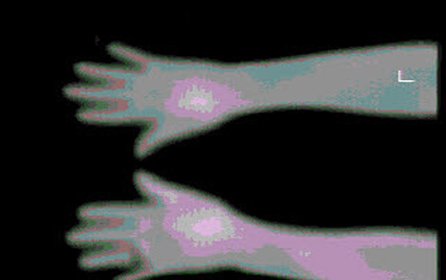Chronic-pain-science
SCIENCE_HOME
See also the successor of this site : https://chronic-pain-science.info/blog/
It's more easy to view and more arranged.
Latest News
2017-07-29
We are working on a solution model of chronic pain (Hypothetically) The first paper-version has been completed. The video-version, designed to be presented in a video-presentation at the upcoming Congress of Pain: Pain Medicine 2017, titled: ““Relieving Pain. Restoring Function. Renewing Hope”. San Francisco. October, 2017 has been completed too.
“Solution” as a model of developing of Chronic Pain and CRPS from bleeding, trauma or inflammation, according the physiologically automatic control system.
The model can explain, why a thermographically ”cold spot” can remain after a initially “hot” traumatic incident, it can explain why a Cold spot can become warmer after “Cold stress", why a Cold Spot can become a CRPS (Complex Regional Pain Syndrome), why a CRPS not only is looking as "Out of Control, but it really is too. It can explain, why a “Cold CRPS” contains inflammatory cytokines and why a relatively small trauma can give rise to a CRPS.
The model can also can explain why a drug as Pentoxifylline, known since 1986 can be useful in treating CRPS.
A preview version of the video "A model about the origin of chronic pain and crps. (1880-2017)": 45 min ! is ready for the use of medical professionals.
The video has been divided into three parts: Past, Present and Future. History, diagnostics and therapy.
This video is temporarily free available. Click here.
An extensive scientifically publication is prepared.
PH(Henk)E van der Veen.
Published on 29/07/2017 door Henk
A Basic paper is available as a preview version.
Click here for the full-text : Postoperative CRPS generation: a hypothesis.
For application in practising see: Goto page:Case Report Prepublishing
Infrared image with pain without a known substrate. on the left side. 1980
*******************
You are on the start page of the scientific part.
In this volume until January 2014 six publications will appear about research done in 1982-1986 including discussion and evaluation based on progressing insight from 1986 up till now.
The background of publication is made by the realization that many patients who cooperated to the research can expect something back for their cooperation. Preferably by the regular and modern media but if that is not possible then only by this virtual way which did not exist yet in 1981-1986.
These publications provide statistically tested conclusions indicating that chronic pain is not a subjective, elusive phenomenon as was and is always thought.
The reason for publication on this site is partly situated in the circumstances that 25 years of research is seen as “obsolete”and not relevant (anymore) and as a result of this can hardly published in the traditional media anymore.
Also the judging criteria for research to be developed have been tightened. Legal standards on how to deal with test persons and the written reporting have been drastically changed.
Furthermore commercial aspects of the media and interest in “quotation indexes”play a role.
Yet the results of the research are sufficiently interesting, still medically and socially relevant to be published.
May the reader appreciate the value.
Research results:
1. Chronic pain spots have a significantly lower temperature than their healthy reference points. P<=0.001.
2. Abdominal pain may be related to processes that occur or occurred in the abdominal organs. Viscero-cutaneous reflex ways exist in human in vivo. P<=0.001
3. There is a correlation between pain sensations and found infrared thermographic measurement information. P<=0.001 Correlation degree 0.69
4. Infrared videothermography is a very sensitive diagnostic method (up to physiological level).
5. There is a slight indication that the pain spots are being influenced by the effect of prostaglandins, at which the different NSAIDs do not have a similar effect on the pain spots.
6. Pentoxyphylline has a significantly positive effect on both cold and hot pain spots. P<=0.001
2012-May-14
P.H.E. van der Veen.
Annemarie Hoogervorst.
Author: PHE van der Veen
Translations: Annemarie Hoogervorst
2016-March 08
Six articles are accepted for publication:
Veen PHE van der, Martens EP. Viscerocutaneous reflexes with abdominal wall pain: A study conducted in 1981 on pregnant women from a general practice. Thermography international. 2013;23(2): 56-63
Available at:
http://www.uhlen.at/thermology-international/index.php
Veen PHE van der. Viscero-cutaneous reflexes in relation to abdominal and pelvic pain. A study from 1982 in females with IUD insertions. Thermography international. 2013;23(3): 87-92
Available at:
http:// www.uhlen.at/thermology-international/index.php
Veen PHE van der. Infrared thermography for pain influenced by a Xanthine derivative: An attempt to assess chronic pain objectively.
Thermology international Vol 24 (2014), No. 2: 39-48
Available at:
http://www.uhlen.at/thermology-international/index.php
Abdominal Wall Pain:
Veen PHE van der. Effects of Placebo Measured by Infrared Thermography.
Thermology international 2014, 24(4) 157-165
Available at:
http://www.uhlen.at/thermology-international/index.php
Veen PHE van der. A theoretical model of biochemical control engineering based on the relation between oestrogens/progestagens and prostaglandins.
Medical Hypotheses 84 (2015), pp. 557-569 DOI information: 10.1016/j.mehy.2015.02.021
Veen PHE van der. CRPS A contingent hypothesis with prostaglandins as crucial conversion factor.
Medical Hypotheses. 85 (2015) 568-575. DOI information: http://dx.doi.org/10.1016/j.mehy.2015.07.017.
